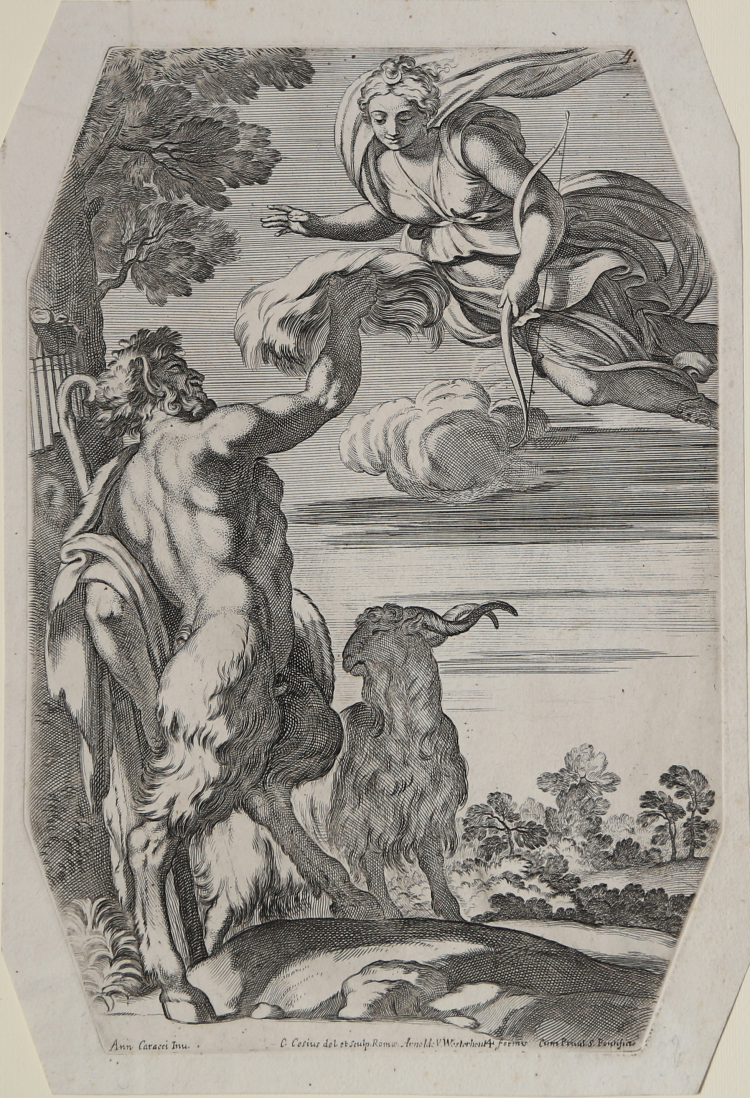



| Reference: | s32422 |
| Author | Carlo CESIO |
| Year: | 1657 |
| Measures: | 245 x 254 mm |


| Reference: | s32422 |
| Author | Carlo CESIO |
| Year: | 1657 |
| Measures: | 245 x 254 mm |
Plate 4 from the series Galeria nel Palazzo Farnese in Roma.del Sereniss. Duca di Parma etc. dipinta da Annibale Carracci intagliata da Carlo Cesio an album after the fresco ceiling in the Farnese Gallery by Annibale Carracci, first published by François Collignon in 1657.
The work consists of 44 etchings made in the same direction as Carracci's frescoes. The fame of these etchings, of which Cesi also made a counterproof, is due to their fidelity to the originals. They were much appreciated despite the coldness that this fidelity often entailed. After the first edition by Collignon, they were in fact replicated in five other editions.
Etching, printed on contemporary laid paper, with margins, in very good condition. Third state with Arnold Van Westerhout imprint.
Carlo Cesio (Antrodoco 1626 - Rieti 1687) was an Italian painter and engraver. After his education in Rieti, in the late 1640s Cesi went to Rome, where he became a pupil of Pietro da Cortona, who later introduced him to various patrons, including Queen Christina of Sweden and Cardinal Decio Azzolini, and supported his matriculation at the Accademia di S Luca in 1651.
The series by Carlo Cesio (or Cesi) constitutes the first Italian graphic translation of this cycle of frescoes. The first edition of this series was published in Rome before 1657 and each print bears Collignon's address and an Arabic series number. The second edition also dates back to 1657 and differs from the first only in the inclusion of an essay entitled 'Argomento della Galeria Farnese dipinta da Annibale Carracci' published by Vitale Mascardi. Upon Collignon's death (Rome 1687), the plates were purchased by Arnold Van Westerhout who reprinted the Cesi series with his own address (second state) instead of Collignon's, eliminated the privilege and the Arabic numerals, and introduced Roman numbering of the plates. This was followed by an edition where the title is accompanied by the inscription 'In Roma nella libraria di Venenzio Monaldini al Corso'. In the fifth edition, Monaldini's address was replaced by that of Girolamo Mainardi; the sixth and final edition was published in Rome in 1753 by Venenzio Monaldini with a new title: 'Aedium farnesiarum tabulae ab Annibale Carraccio ...'.
Bibliografia
Bartsch, Le peintre-graveur (1803-1821) XXI.109.21-64; Bellini P., Carlo Cesio in “Italian Masters of the Seventeenth Century (The Illustrated Bartsch, vol. 47, 1983)”, pp. 78-99, nn. 021-064; E. Borea, Annibale Carracci e i suoi incisori (1986).
Carlo CESIO (Antrodoco 1626 - Rieti 1687)
|
Italian painter and engraver. After his education in Rieti, in the late 1640s Cesi went to Rome, where he became a pupil of Pietro da Cortona, who later introduced him to various patrons, including Queen Christina of Sweden and Cardinal Decio Azzolini, and supported his matriculation at the Accademia di S Luca in 1651. In 1657 Cesi took part in the decoration of the Galleria di Alessandro VII in the Palazzo Quirinale with his Judgement of Solomon (in situ). The fresco shows that he had not completely understood Baroque style but continued to build his compositions by adding figures, unable to reach a real unity. This weakness becomes more evident in his later works. In 1657, too, Cesi published his series of prints from Annibale Carracci’s frescoes in the Galleria Farnese. The series after Pietro da Cortona’s decoration in the Galleria Pamphili came out in 1661. The fame of these etchings, in which Cesi never reversed the image, was due to their faithfulness to the originals; they were highly appreciated in spite of the cold quality often imparted by this exactitude. Around 1660 Cesi painted the Marriage of St Catherine and the Holy Family for the Cesi chapels in S Maria Maggiore and S Maria della Pace, Rome, respectively. He worked in Rieti in 1673–4, and he retired in 1679. The period between 1672 and 1675 was his busiest at the Accademia di S Luca, where he was Principe in 1675. Cesi devoted much time and effort to teaching, as is testified by his book Cognizione dei muscoli (Rome, 1679).
|
Carlo CESIO (Antrodoco 1626 - Rieti 1687)
|
Italian painter and engraver. After his education in Rieti, in the late 1640s Cesi went to Rome, where he became a pupil of Pietro da Cortona, who later introduced him to various patrons, including Queen Christina of Sweden and Cardinal Decio Azzolini, and supported his matriculation at the Accademia di S Luca in 1651. In 1657 Cesi took part in the decoration of the Galleria di Alessandro VII in the Palazzo Quirinale with his Judgement of Solomon (in situ). The fresco shows that he had not completely understood Baroque style but continued to build his compositions by adding figures, unable to reach a real unity. This weakness becomes more evident in his later works. In 1657, too, Cesi published his series of prints from Annibale Carracci’s frescoes in the Galleria Farnese. The series after Pietro da Cortona’s decoration in the Galleria Pamphili came out in 1661. The fame of these etchings, in which Cesi never reversed the image, was due to their faithfulness to the originals; they were highly appreciated in spite of the cold quality often imparted by this exactitude. Around 1660 Cesi painted the Marriage of St Catherine and the Holy Family for the Cesi chapels in S Maria Maggiore and S Maria della Pace, Rome, respectively. He worked in Rieti in 1673–4, and he retired in 1679. The period between 1672 and 1675 was his busiest at the Accademia di S Luca, where he was Principe in 1675. Cesi devoted much time and effort to teaching, as is testified by his book Cognizione dei muscoli (Rome, 1679).
|